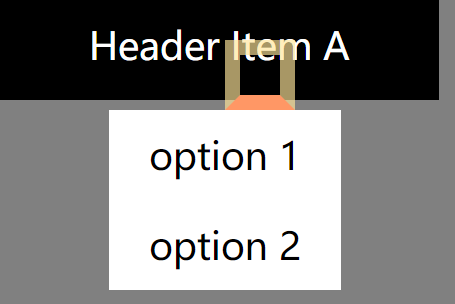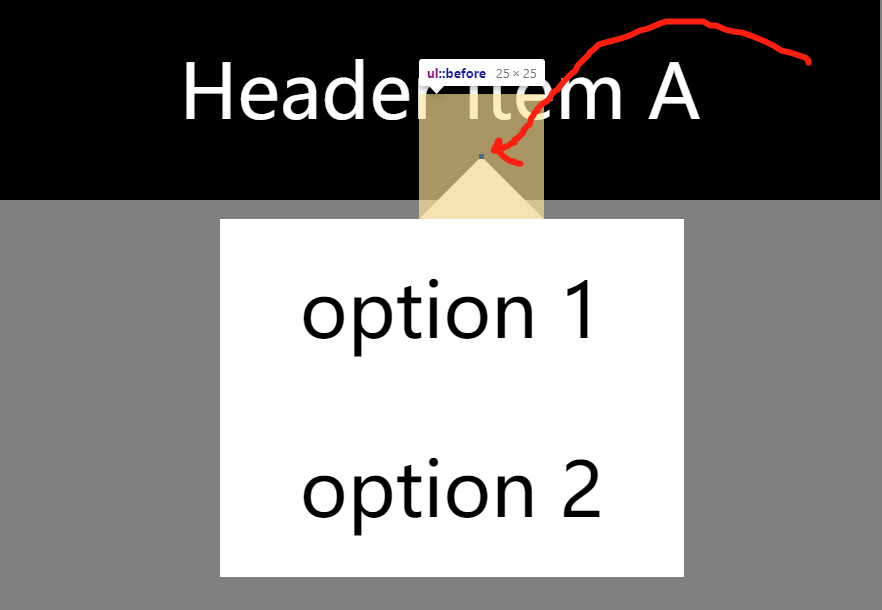CSS - a dropdown menu with a triangle
# Summary
A triange can be made by a element with the following style
1. width:0
2. height:0
3. border-width
the value of it depends on the margin-top of dropdown
normally, half value of margin-top (caz you have top and bottom border)
4. border: solid transparent
transparent is needed for overlapping background-color taken from parent element
4. border-bottom-color
5. content (if it is a pseudo element)
To make menu item look like centrally align, simply just use `padding`
2
3
4
5
6
7
8
9
10
11
12
# Notes
So I saw a css effect and was wondering how that was made. It used around half an hour to identify that effect, just because I paid attention to a wrong html tag 😦
The css effect I want to know is shown in the following picture.

The triange that the red arrow points to is the one I am taking about. Shortly speaking, position + pseudo-classes:hover + pseudo-elements:before plays the role (IDK why they use :after, it seems unnecessary).
So how they do that?
# Step 0. make a dropdown list
First, you need a menu item or anything else to be a reference. Let's say, the menu. So, set that menu as position: relative; Then, surely we will have pseudo elements :before and :after as absolute position elements according to the menu, which appear when the pointer hovers onto.
Now here is what we have by now.
<style>
html *{
font-size: 15px;
padding: 0;
margin: 0;
}
html{
background: grey;
}
.header-menu-item{
width: 10rem;
min-height: 1.5rem;
padding: 0.5rem;
text-align: center;
background: black;
color: white;
position: relative;
}
.header-menu-item ul{
display: none;
}
.header-menu-item:hover ul {
list-style: none;
color: black;
background: white;
position: absolute;
left: 25%;
margin-top: 1rem;
display: block;
}
.header-menu-item:hover ul li{
padding: 0.5rem 1rem;
}
</style>
<div class="header-menu-item">
<a>Header Item A</a>
<ul>
<li>option 1</li>
<li>option 2</li>
</ul>
</div>
2
3
4
5
6
7
8
9
10
11
12
13
14
15
16
17
18
19
20
21
22
23
24
25
26
27
28
29
30
31
32
33
34
35
36
37
38
39
40
41
42
# Step 1. attach a pseudo element to the menu
Then, attach a :before same as what ul do. The code below is what I saw from the site and I extracted the attributes only needed for this effect.
.header-menu-item:hover ul:before{
content: " ";
position: absolute;
bottom: 100%;
left: 43%;
border: solid transparent;
border-bottom-color: rgb(225, 225, 225);
border-width: 0.5rem;
}
2
3
4
5
6
7
8
9
This is kind of like a piece of magic code. The pseudo element is just an element with a bottom border and attached to the top of dropdown menu, so why is it a triange?
After some attempts of changing the attributes, the theory behind magic is revealed.

What you can see in this picture is the :before element with width and height more than 0. Normally you will use border with a element has some size, then surely it is a border. But if the element has no size, it becomes a triange, and the direction of that triange is according to what attribute, such as border-top, border-bottom you use.
So what does a "triangle" element contains?

The tiny content(I set w&h to 1px) is at the center of the element and the rest is the trianges/borders. And the way to adjust the size of triange is to use border-width.
# The full snippet of code
<style>
html *{
font-size: 15px;
padding: 0;
margin: 0;
}
html{
background: grey;
}
.header-menu-item{
width: 10rem;
min-height: 1.5rem;
padding: 0.5rem;
text-align: center;
background: black;
color: white;
position: relative;
}
.header-menu-item ul{
display: none;
}
.header-menu-item:hover ul {
list-style: none;
color: black;
background: white;
position: absolute;
left: 25%;
margin-top: 1rem;
display: block;
}
.header-menu-item:hover ul li{
padding: 0.5rem 1rem;
}
.header-menu-item:hover ul:before{
content: " ";
position: absolute;
bottom: 100%;
left: 43%;
border: solid transparent;
border-bottom-color: rgb(225, 225, 225);
border-width: 0.5rem;
}
</style>
<div class="header-menu-item">
<a>Header Item A</a>
<ul>
<li>option 1</li>
<li>option 2</li>
</ul>
</div>
2
3
4
5
6
7
8
9
10
11
12
13
14
15
16
17
18
19
20
21
22
23
24
25
26
27
28
29
30
31
32
33
34
35
36
37
38
39
40
41
42
43
44
45
46
47
48
49
50
51
